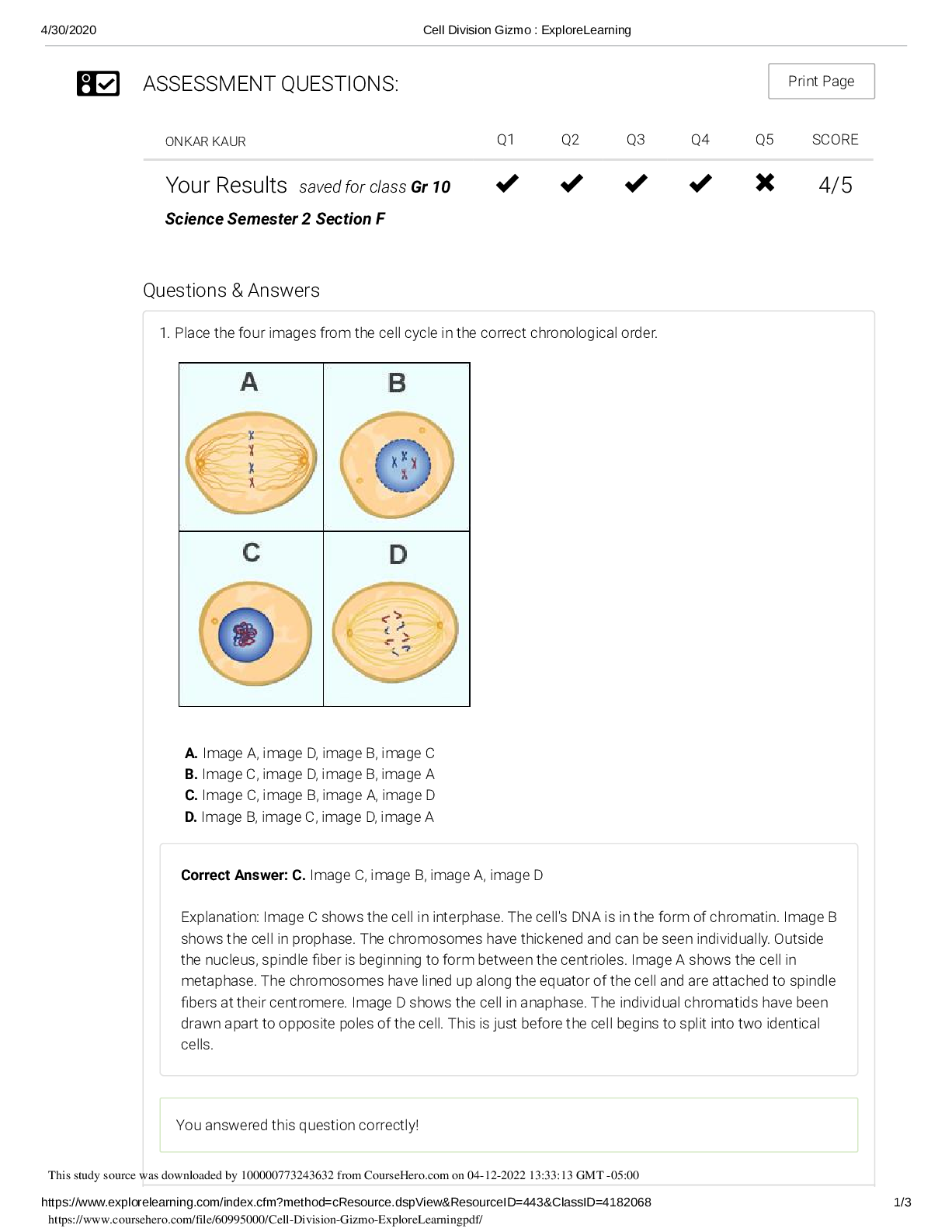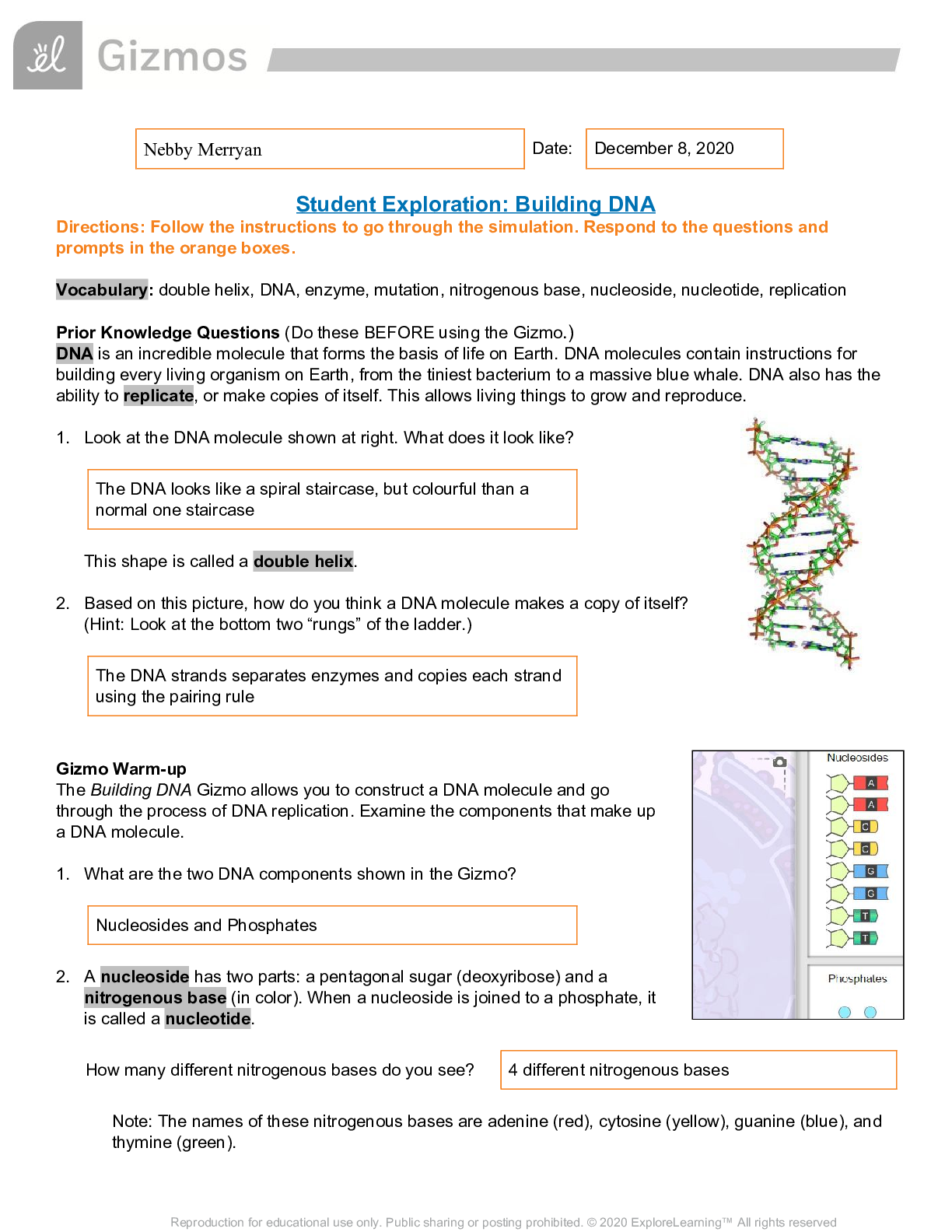WavesGizmo. Early College HS. graded A+. Accurate answers provided
Document Content and Description Below
Student Exploration: Waves Vocabulary: amplitude, compression, crest, frequency, longitudinal wave, medium, period, power, rarefaction, transverse wave, trough, wave, wavelength, wave speed Prior K... nowledge Questions (Do these BEFORE using the Gizmo.) 1. A buoy is anchored to the ocean floor. A large wave approaches the buoy. How will the buoy move as the wave goes by? A buoy will move down and up as the wave goes by. 2. The two images show side views of ocean waves. How are the two sets of waves different? The first wave is a longitudinal wave and the other one is a transverse wave also in the second one the distance is separated more. Gizmo Warm-up Ocean swells are an example of waves. In the Waves Gizmo™, you will observe wave motion on a model of a spring. The hand can move the spring up and down or back and forth. To begin, check that the Type of wave is Transverse, Amplitude is 20.0 cm, Frequency is 0.75 Hz, Tension is 3.0 N, and Density is 1.0 kg/m. Click Play ( ). 1. How would you describe the motion of a transverse wave? The wave moves left to right while the hand moves up and down. Click Pause ( ). Notice the crests (high points) and troughs (low points) of the wave. 2. Click Reset ( ). For the Type of wave, choose Longitudinal. Increase the Amplitude to 20.0 cm, and click Play. How would you describe the motion of a longitudinal wave? In this wave the hand is moving from left to right as well as the wave. Click Pause. Notice the compressions in the wave where the coils of the spring model are close together and the rarefactions where the coils are spread apart. This study source was downloaded by 100000773243632 from CourseHero.com on 03-29-2022 03:48:37 GMT -05:00 https://www.coursehero.com/file/21699604/WavesGizmo/ Activity A: Measuring waves Get the Gizmo ready: Click Reset. Select Transverse waves. Set Amplitude to 20.0 cm, Frequency to 1.0 Hz, Tension to 2.0 N, and Density to 2.0 kg/m. Question: How do we measure and describe waves? 1. Observe: Click Play. Observe the motions of the hand and of the green dot in the middle. A. What is the motion of the hand? Moves up and down. B. Turn off the Lights on checkbox and observe the green dot. What is the motion of the green dot? Moves up and down. C. Follow the motion of a single crest of the wave. How does the crest move? The crest moves from left to right. In a transverse wave, the motion of the medium (what the wave moves through—in this case, the spring) is perpendicular to the direction of the wave. So, each point of the spring moves up and down as the wave travels from left to right. 2. Measure: With the lights on, click Pause. Turn on Show rulers. A. Use the horizontal ruler to measure the horizontal distance between two crests. What is this distance? 100cm This is the wavelength of the wave. B. What is the distance between the two troughs? 100cm The wavelength can be found by measuring the distance between two successive crests, two successive troughs, or any two equivalent points on the wave. C. Click Reset. Set the Density to 1.0 kg/m. Click Play, and then Pause. What is the wavelength of this wave? 140cm [Show More]
Last updated: 2 years ago
Preview 1 out of 7 pages
.png)
Buy this document to get the full access instantly
Instant Download Access after purchase
Buy NowInstant download
We Accept:

Reviews( 0 )
$7.00
Can't find what you want? Try our AI powered Search
Document information
Connected school, study & course
About the document
Uploaded On
Mar 29, 2022
Number of pages
7
Written in
Additional information
This document has been written for:
Uploaded
Mar 29, 2022
Downloads
0
Views
68













